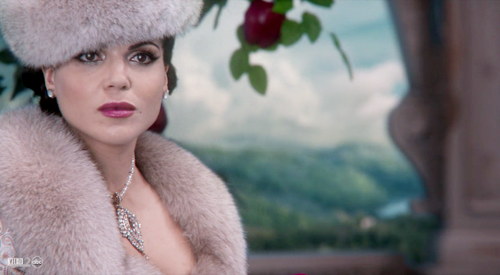|
A Tale Of Two Reginas By Teresa Martin (@Teresa__Martin) The story of Snow White begins with a classic description of the heroine: “skin as white as snow and red as blood, [with] hair as black as ebony (Grimm, 51).” While young Snow’s adventures are the focus of the fairy tale, there is a fascinating character who wishes the child nothing but death: her very own step-mother who is, incidentally, queen of her land. There are two versions of this murderous regent that are presented here as subjects for analysis. One is from the Grimm narrative, and the other from the modern television show Once Upon a Time. While events happen differently in the two renditions, the symbolism remains the same. Both queens commit deadly trespasses which poison their souls and lead them to spiritual death. In the Grimm version of Snow White, the Queen is first introduced after she marries Snow’s widowed father. She is described as being beautiful, but also proud and frivolous. It is not by coincidence that pride is the first vice listed. Hubris, disproportionate pride, is present in literature from the classics of Homer to the Summa Theologica of Thomas Aquinas. The latter stated “. . . . that pride denotes something opposed to right reason (Question 161, Article 1).” Hubris can further be defined as “. . . .a belief that he or she is somehow above the fates, or in control of destiny (Best).“ By people’s own will, usually manifested in the rejection of self-knowledge through truth, the remedy is eluded. As a result, the individuals continue miring themselves in other ill-gotten acts, which often escalate to murder. The cure is the opposite of pride: humility. If this virtue were embraced by the Queen, she would need to give up her desire to be more beautiful than Snow White. However, there is no indication that she sees this path as an option. When one considers that her other trait is frivolity, the Queen can only be the dangerous person that the story describes. Equally alarming is Regina, Latin for Queen. She is first seen in Once Upon a Time when she barges into a wedding, head held high, and announces that she will take away everybody’s happiness. Her earnestness makes the scene all the more disturbing, for she is obviously not in control of her reason. While it is understandable to be upset because others receive the happiness for which one wishes, to actively seek the destruction of an entire world, and announce her intention with confidence, clearly reveals her psyche. This woman is insane. The root of madness in both women is envy. However, the motivations for their common vice are different. In Once Upon a Time, Regina is envious of Snow because she has her “Happy Ending” by marrying the man she loves. She connects this with her step-daughter because she believes that Snow is culpable for the death of her one true love, Daniel. In Regina’s manner of thinking, it is therefore justice to take away Snow’s happiness. This is why she casts the great curse which transports all from the Enchanted Forest to Storybrooke. It is a sociopathic, perhaps psychotic, response to a twelve-year old’s innocent mistake. In contrast, and far more eerie, the Queen in the Grimm version feels envy because a seven-year old is prettier than she. When the famous magic mirror tells her that Snow is the fairest in the land, the Queen becomes “yellow and green with envy (Grimm, 53).” While green is often a positive image, in the context of the story it takes on another aspect. “Satan himself [the epitome of envy] is sometimes represented as green. Perhaps this stems from the fact that green is not the skin-colour of healthy normality (Tresidder, Loc. 2077-2081).” Yellow is also sometimes used to describe illness, such as the color of a person’s visage when struck with the plague (Tresidder, Loc. 5298). As yellow and green do not represent the health of the body, neither can they represent a healthy soul. Furthermore, an emblem that can be ascribed to Snow’s stepmother is the Moon, since that is the traditional symbol for a Queen. The Moon is also considered a symbol of insanity, as the word lunacy is based on the Latin for Moon. In addition, the Moon is a suitable representation of the Queen, since it is only visible to those on Earth because it reflects the light of the Sun. This satellite is therefore the ultimate mirror. Because it can only reflect what it sees, a mirror is recognized as a symbol of truth. Hence it is fitting that a magic Mirror informs the Queen that Snow is the fairest of them all. The Queen, knowing the mirror cannot lie, has no reason to doubt what she hears. In her manner of thinking, Snow has usurped her rightful place as the most comely in the land. Instead of accepting this, the Queen attempts great evil to rid the world of her perceived rival. Comparisons with the vain Queen as written by the Grimm Brothers and the story of Narcissus are common and appropriate. Narcissus was a Greek hunter who was exceptionally handsome. The god Nemesis, in order to punish him for his pride and vanity, forced him to a pond where he looked at his own image. Narcissus proceeded to become so entranced with himself that he could not tear his eyes away. He stayed in such a state until he died. The lesson of the story is that obsession with one’s transient beauty can only lead to death. This happens literally in the Grimm version. The Queen cannot give up her desire to be the most beautiful, and obsesses about it until she attempts murder with the infamous, red apple. When that plan is thwarted by the prince, she still cannot bring herself to be absent from Snow’s wedding. Her motivation is that she is certain her step-daughter will be a more attractive bride than she had been. Just as Narcissus could not keep himself from his reflection, the Queen could not stay away from the wedding, and for this she is punished. When she enters the hall, there are iron red-hot slippers forced upon her and she must dance until she dies. Shoes are a symbol of humility. Since the Queen will not allow herself to be humbled, ultimately the remedy for her vice is clamped upon her by force, symbolized by the unbreakable iron. She is tortured to death by her own choice. Regina in Once Upon a Time is still alive and physically healthy when she makes her last appearance in Season One. She is not in immediate danger of physical death, but from the premiere of the show, her soul has had no life. In the second episode, Regina chooses to kill her beloved father. Knowing her plan, he pleads with her in a heartbreaking dialogue to give up her hatred so that she can be happy. Regina, in tears, says that she does want to be happy, and rips out his heart. Since Regina loved her father, when she tears out his heart, the sign of love, she is really tearing out her own. Yet there is an enigma with Regina. She has a son, Henry, whom she named after her father. In perhaps one of the most poignant scenes of the season, she declares her maternal love for him. For a moment it is not clear that she is sincere, because she often uses tears for her own gain. Regina’s sincerity is only confirmed when she returns to her home after losing him. As she goes to Henry’s bedroom, she picks up his pillow, and sobs into it. There are no spectators at this point and hence anybody to deceive. This is the true Regina. However, the brief moment of sanity is eclipsed when she realizes that magic is returning to Storybrooke. One look at the purple cloud causes her to smile in anticipation of revenge. She has not learned. Scrutinizing these two queens, one is presented with characters of depth that use their free-will to harm others. But there is a difference in the conclusions because the reader of the older Grimm tale has the satisfaction of seeing the Queen receive her just punishment. The viewer of Once Upon a Time has not yet been given such a resolution. Perhaps this will never occur since the scene showing Regina weeping over her son may be a foreshadowing of future redemption. Wondering whether she will dance to her grave, or be lifted up to a redeemed life is part of the excitement the audience can rightly anticipate in future seasons. Works Cited Best, Michael. "Greek Terms Used in Tragedy." Internet Shakespeare Editions, University of Victoria:
Victoria, BC, 2001-2010. <http://internetshakespeare.uvic.ca/Library/SLT/help/introcite.html>. Brüder Grimm. “Schneewittchen. “ Aschenputtel und andere Märchen gesammelt von den Brüdern Grimm. Bonn, Inter Nationes, 1985. Cirlot, J.E. A Dictionary of Symbols, Second Edition. Taylor and Francis e-Library, 2001. Tresidder, Jack. The Watkins Dictionary of Symbols (Kindle Edition). London: Watkins Publishing, 2011.
0 Comments
Leave a Reply. |
OriginsExplore the Arthurian legend surrounding Lancelot, take a trip into the woods to discover the mythology behind Red Riding Hood or learn more about a modern day hero called Snow White. Origins provides unique insights and perspectives from talented writers into the characters we know and love, going far beyond the boundaries of Storybrooke. Archives
August 2016
Categories
All
|




